UPSC Daily Current Affairs- 13th October 2023 | Current Affairs & Hindu Analysis: Daily, Weekly & Monthly PDF Download
GS-I
India ranks 111th on Global Hunger Index2023
Subject: Social Issues
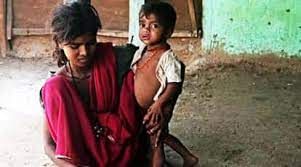
Why in News?
India ranked 111th out of 125 countries in the Global Hunger Index 2023, a standing the government termed “erroneous and having malafide intent”.
About Global Hunger Index (GHI):
- Created in 2006, the GHI was initially published by the US-based International Food Policy Research Institute (IFPRI) and Germany-based Welthungerhilfe.
- In 2007, the Irish NGO Concern Worldwide also became a co-publisher.
- In 2018, IFPRI stepped aside from its involvement in the project and the GHI became a joint project of Welthungerhilfe and Concern Worldwide.
What does GHI Indicate?
- The global hunger index is a means of monitoring whether countries are achieving hunger-related Sustainable Development Goals (SDGs). It can be used for international ranking.
- Goal 2 of the SDGs aims to end hunger and all forms of malnutrition by 2030.
- It also commits to universal access to safe, nutritious and sufficient food at all times of the year.
How is GHI Defined?
- The GHI captures three dimensions of hunger –
- Insufficient availability of food,
- Shortfalls in the nutritional status of children and
- Child mortality
Consequences & Implications:
- Hunger is one of the world's major problems and, therefore, one of its most important challenges.
- Hunger and undernourishment form a vicious circle, which is often "passed on" from generation to generation.
- The children of impoverished parents are often born underweight and are less resistant to disease; they grow up under conditions that impair their intellectual capacity for their whole lives.
- Factors that contribute to a high global hunger index have been identified as:
- Low income and poverty,
- War and violent conflict,
- General lack of freedom,
- Low women's status, and
- Poorly targeted and delivered health and nutrition programmes.
News Summary:
- India ranked 111th out of 125 countries in the Global Hunger Index-2023 with the country reporting the highest child wasting rate at 18.7 per cent.
- India ranked 107th out of 121 countries in 2022.
- With a score of 28.7 in the Global Hunger Index-2023, India has a level of hunger that is serious, according to a report based on the index.
- The 2023 GHI score for the world is 18.3, considered moderate and less than one point below the world's 2015 GHI score of 19.1.
- India's neighbouring countries Pakistan (102th), Bangladesh (81st), Nepal (69th) and Sri Lanka (60th) have fared better than it in the index.
- South Asia and Africa South of the Sahara are the world regions with the highest hunger levels, with a GHI score of 27 each, indicating serious hunger.
Criticism of the Report by the Union Government:
- The Ministry of Women and Child Development (MoWCD) yet again questioned the GHI and called it a “flawed measure of hunger that doesn’t reflect India’s true position”.
- It said that data recorded on its Poshan Tracker portal showed child wasting prevalence of 7.2% among a total of 7.24 crore under-five-year-olds whose data was captured, whereas the GHI used a value of 18.7% for child wasting.
- The ministry further said two other indicators, namely stunting and wasting, are outcomes of complex interactions of various other factors like sanitation, genetics, environment and utilisation of food intake apart from hunger which is taken as the causative/outcome factor for stunting and wasting in the GHI.
- The second objection the MoWCD reiterated was the alleged use of a telephone-based opinion poll to calculate undernourishment, one of the indicators used in GHI.
- The GHI has maintained that it doesn’t use the poll, but relies on data from India’s Food Balance Sheet to calculate undernourishment.
- The Ministry argued that three out of the four indicators used for calculation of the index are related to the health of children and cannot be representative of the entire population.
Source: Indian Express
Large Ozone Hole detected over Antarctica
Subject: Geography
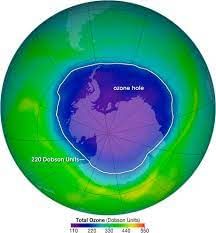
Why in News?
Satellite measurements conducted over Antarctica have unveiled a gigantic hole in the ozone layer.
- Termed an “ozone-depleted area,” this region spans 26 million square kilometers (10 million square miles), approximately three times the size of Brazil.
Ozone Layer and Ozone Hole
| Location | Stratosphere, approximately 10-30 km above Earth’s surface. |
| Composition | Composed of ozone (O3) molecules. Unit of measurement: Dobsob Unit (DU) |
| Function | Acts as a protective shield, absorbing and blocking a significant portion of harmful ultraviolet (UV) radiation from the sun. |
| Importance | Essential for protecting life on Earth by preventing excessive UV radiation, which can harm living organisms and the environment. |
| Ozone-depleting Substances | Threatened by ODS like chlorofluorocarbons (CFCs), halons, and other synthetic compounds commonly used in refrigeration, air conditioning, and aerosol propellants. |
| Montreal Protocol | An international treaty adopted in 1987 to phase out the production and consumption of ODS, resulting in significant recovery of the ozone layer. |
| Current Status | The ozone layer is in the process of recovery due to the success of the Montreal Protocol. |
| Environmental Impact | Protects ecosystems, prevents skin cancer, cataracts, and other health issues in humans. |
| Additional Facts | • The size of the ozone hole over Antarctica varies annually, opening in August and closing in November or December. • Special winds caused by the Earth’s rotation create a unique climate over Antarctica, preventing mixing with surrounding air. • When these winds subside, the hole closes. |
Potential Causes of the Giant Ozone Hole
- Volcanic Eruption in Tonga: Scientists speculate that the extensive ozone hole this year may be linked to volcanic eruptions in Hunga Tonga, Tonga, between December 2022 and January 2023. These eruptions released water vapor and other elements into the stratosphere, impacting the ozone layer through chemical reactions.
- Human-Induced Ozone Holes: In the 1970s, scientists discovered that human activities, primarily the use of chlorofluorocarbons (CFCs), led to significant ozone depletion. These chemicals released chlorine in the stratosphere, depleting the ozone layer.
- Effective Mitigation: The Montreal Protocol, established in 1987, aimed to combat ozone depletion by phasing out ozone-depleting substances. This international agreement successfully reduced the size of ozone holes over the years.
Ozone Depletion and Climate Change
- Not a Primary Climate Change Cause: Ozone depletion is not a leading contributor to global climate change.
- Impact of Rising Temperatures: However, rising global temperatures may influence ozone holes. Extreme fires, such as those in southeastern Australia in 2020 and 2021, injected smoke into the stratosphere, potentially contributing to ozone depletion.
- Changing Seasons: Ozone holes can alter the progression of seasons, as they extend the duration of polar vortexes, thereby extending winter periods.
Source: Indian Express
GS-II
Mera Yuva Bharat (MY Bharat)
Subject: Polity and Governance

Why in News?
The government has recently approved the establishment of an autonomous body Mera Yuva Bharat (MY Bharat) for development of youth and youth-led development.
Background:-
- Briefing reporters in New Delhi after the Cabinet meeting, Information and Broadcasting Minister Anurag Singh Thakur said that there are nearly 40 crore youth in the country who are in the age group of 15-29 years.
- The body will be dedicated to the nation on October 31, the birth anniversary of Sardar Vallabhbhai Patel.
About Mera Yuva Bharat (MY Bharat):-
- Establishment: 2023.
- Ministry: Ministry of Youth Affairs and Sports.
- Mera Yuva Bharat (MY Bharat) is an autonomous body.
- It will serve as an overarching enabling mechanism powered by technology for youth development and youth-led development.
- Objective: The primary objective of Mera Yuva Bharat (MY Bharat) is to make it a whole of Government platform for youth development.
- Under the new arrangement, with access to resources & connection to opportunities, youth would become community change agents and nation builders allowing them to act as the Yuva Setu between the Government and the citizens.
- It seeks to harness the immense youth energy for nation-building.
- It will benefit the youth in the age group of 15-29 years, in line with the definition of ‘Youth’ in the National Youth Policy.
- In the case of programme components specifically meant for adolescents, the beneficiaries will be in the age group of 10-19 years.
- It will provide equitable access to youth to actualize their aspirations and build Viksit Bharat across the entire spectrum of the Government.
Advantages:-
- Leadership Development in the Youth.
- Better alignment between youth aspirations and community needs.
- Enhanced efficiency through Convergence of existing programmes.
- Act as a one-stop shop for young people and Ministries.
- Create a centralized youth database.
- Improved two-way communication to connect youth government initiatives and activities of other stakeholders that engage with youth.
- Ensuring accessibility by creating a physical ecosystem.
Significance: –
- It will help ensure accessibility by creating a physical ecosystem.
- It will help to increase the Youth outreach efforts of the Department of Youth Affairs.
Source: PIB
Why China has assisted Sri Lanka over debt worth $4.2 billion
Subject: International Relations
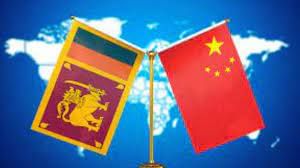
Why in News?
More than a year after Sri Lanka plunged into an economic crisis, it has reached an agreement with the Export-Import (EXIM) Bank of China to cover about $4.2 billion of its outstanding debt.
- The indicative terms agreed will provide the necessary fiscal space for Sri Lanka to implement its ambitious reform agenda.
Why does Sri Lanka Need Assistance with its Foreign Debt?
- In (April) 2022, Sri Lanka declared that it had failed to repay its debt of more than $83 billion, with more than half of it owed to foreign creditors. It also decided to approach the International Monetary Fund (IMF).
- The crisis was years in the making and many factors were responsible, such as the -
- President Gotabaya Rajapaksa’s government pushed through the largest tax cuts in Sri Lankan history, as part of the 2019 elections campaign, impacting the government’s revenue sources.
- Another blow was dealt by the coronavirus pandemic, which hit the tourism industry. The war in Ukraine further contributed to fuel shortages.
- Skyrocketing inflation saw many Sri Lankans take to the streets to protest against the government and the then-President Rajapaksa resigned.
How has Sri Lanka Planned to Tide Over its Economic Crisis?
- To increase revenues and signal better governance, it will be important for Sri Lanka to strengthen tax administration, remove tax exemptions and actively eliminate tax evasion.
- In the interim, the then President had sought help from China and India, particularly assistance on fuel from the latter.
- A diesel shipment under a $500 million credit line was signed with India. Later, a $1 billion credit line for importing essentials, including food and medicine was also extended.
- In (September 2022), Sri Lanka qualified for an IMF Extended Fund Facility of $2.9 billion. Its first tranche of $330 million came through in (March) 2023.
- However, the debt owed to other countries had to be managed through negotiations (called debt restructuring), for the IMF to extend its loan to Sri Lanka.
- Generally, debt restructuring can lead to reduced loan interest rates or an extension of its repayment date.
What are the Concerns over Sri Lanka’s Debt Negotiations?
- A debt restructuring agreement between Sri Lanka and countries such as Japan, India, and France were expected (in September 2023) but did not materialise.
- Through the Paris Group, which includes countries like Japan and South Korea, there was an attempt from countries to bring China and India on board and negotiate as a whole - to make sure no nation gets preferential terms.
- Of the total bilateral debt Sri Lanka owes to foreign governments, China’s share is the greatest, followed by Japan and India.
- But China has largely gone for bilateral negotiations in the past, with confidential terms.
- India has had two major concerns about joining a common platform that does not have China:
- It leaves China to enter into its own custom-made bilateral agreement;
- The Sri Lankan side has indicated that this year's emergency aid from India totalling $4 billion should be included in the restructuring, which New Delhi does not agree with.
What are the Implications of the Recent Sri Lanka-China Deal?
- The agreement with China’s EXIM Bank will assist Sri Lanka in getting past the first review of the IMF programme in the coming weeks and in securing the release of the 2nd IMF tranche of about $334 million.
- For India, China’s assistance to Sri Lanka will be seen as another means through which it is investing in deepening its ties with the island nation.
- In recent years, Sri Lanka also joined the Chinese infrastructure financing project, the Belt and Road Initiative (BRI), which India opposes.
- As part of it, China funded the development of Hambantota port in southern Sri Lanka, which falls on the crucial trade routes between Southeast Asia, Africa and West Asia.
- It was taken over in 2017 after Sri Lanka failed to pay for its costs. This has been termed ‘debt-trap diplomacy’ by many, as a means for China to assert itself and acquire overseas assets through its increased economic heft.
- India has concerns that China’s increasing presence in its immediate neighbourhood could further embolden Chinese military presence, also potentially allowing them to conduct surveillance in the region.
Source: Indian Express
GS-III
Recent GI tags awarded
Subject: Economics
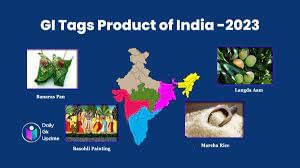
Why in News?
The 23rd Council of Ministers of the Indian Ocean Rim Association (IORA) met recently.
About the 23rd Council of Ministers of IORA:-
- Date: 11 October 2023.
- Host: Sri Lanka.
- Venue: Colombo, Sri Lanka.
- Theme: “Strengthening Regional Architecture: Reinforcing Indian Ocean Identity.
- Sri Lanka assumed the chairmanship from
- Sri Lanka will serve as chair for the next two years.
- India has assumed the Vice Chair in the Indian Ocean Rim Association (IORA) for the next two years.
About Indian Ocean Rim Association (IORA):-
- Establishment: 1997.
- Secretariat: Cyber City, Ebène, Mauritius.
- Objective: to ensure the sustainable development of the Indian Ocean region.
- The IORA is an intergovernmental organization.
- It was formerly known as the Indian Ocean Rim Initiative and the Indian Ocean Rim Association for Regional Cooperation (IOR-ARC).
- Membership: It comprises 23 member states and 11 dialogue partners hailing from regions surrounding the Indian Ocean.
- Members: Australia, Bangladesh, Comoros, French Republic, India, Indonesia, Iran, Kenya, Madagascar, Malaysia, Mauritius, Mozambique, Oman, Seychelles, Singapore, Somalia, South Africa, Sri Lanka, Tanzania, Thailand, the United Arab Emirates, the Maldives, and Yemen.
- In 2014, India hosted the first Indian Ocean Dialogue in Kochi, Kerala.
Structure:-
- IORA’s apex body is the Council of Foreign Ministers (COM) which meets annually.
- It is the highest decision-making body of IORA.
- The United Arab Emirates (UAE) assumed the role of Chair from November 2019 – November 2021, followed by the People’s Republic of Bangladesh from November 2021 – November 2023.
- A committee of Senior Officials (CSO) meets twice a year to progress IORA’s agenda and consider recommendations by Working Groups and forums of officials, business and academics.
Functions:-
- It manages, coordinates, services and monitors the implementation of policy decisions, work programmes and projects adopted by the member states.
- Strengthen regional cooperation and promote sustainable development within the Indian Ocean region.
- Development through economic cooperation.
Focus Areas:-
- Maritime Security
- Trade and Investment Facilitation
- Fisheries Management
- Disaster Risk Reduction
- Academic and Scientific Cooperation
- Tourism Promotion and Cultural Exchanges
- Blue Economy
Significance:-
- The association gains importance by the fact that the Indian Ocean carries half of the world’s container ships, one-third of the world’s bulk cargo traffic and two-thirds of the world’s oil shipments.
- It is a lifeline of international trade and transport and the Indian Ocean region is woven together by trade routes and commands control of major sea lanes.
Source: AIR
Dengue
Subject: Science and Technology
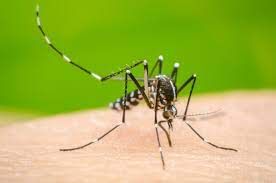
Why in News?
Bihar witnesses 371 fresh cases of Dengue in 24 hours.
Background:-
- Last month, Bihar officially reported a distressing tally of a dozen deaths attributed to dengue.
About Dengue:-
- Dengue is a vector-borne disease.
- Caused by: dengue virus (DENV).
- Transmission: It is transmitted to humans through the bite of an infected female Aedes Aegypti mosquito.
- The mosquito becomes infected when it feeds on the blood of a person infected with the virus.
- There are 4 serotypes of the virus that cause dengue.
- These are known as DEN-1, DEN-2, DEN-3, and DEN-4.
- Dengue cannot be spread directly from person to person.
- Most cases occur in tropical areas of the world, including the Indian subcontinent, Southeast Asia, Southern China, Taiwan, the Pacific Islands, the Caribbean, Mexico, Africa, and Central, and South America.
- It is more common in tropical and subtropical climates.
- It is mostly in urban and semi-urban areas.
- As per WHO, about half of the world’s population is now at risk of dengue with an estimated 100–400 million infections occurring each year.
Symptoms:-
- High fever (40°C/104°F)
- Severe headache
- Pain behind the eyes
- Muscle and joint pains
- Nausea
- Vomiting
- Swollen glands
- Rash.
Treatment
- Most cases of dengue fever can be treated at home with pain medicine.
Prevention:-
- DNA Vaccines: DNA vaccines are often referred to as third-generation vaccines.
- Wear protective clothing.
- Use mosquito repellent.
- Reduce mosquito habitat.'
Source: DTE
Prosopis juliflora
Subject: Environment

Why in News?
The National Security Guard (NSG) decided to take on the vilayati kikar (Prosopis juliflora) populating its Aravali hills campus, after it was found to be responsible, among other reasons, for the depleting water table.
About Prosopis juliflora:
- It is a shrub or small tree in the family Fabaceae, a kind of mesquite.
- It is native to Mexico, South America and the Caribbean.
- It is one of the most invasive species in arid and semi-arid areas.
- It was brought to Delhi by the British in the 1920s, when the national capital was being built.
- In India it is known locally by many names such as Bellary jaali, seemai karuvelam, seemai jaali, gando baval, vilayati kikar.
- It has a very wide ecological adaptability which can grow on soils from sand dune to clay soil, and from saline to alkaline soil type.
- It can grow below 200 to above 1500 m above sea level, and with a mean annual rainfall ranging from 50 to 1500 mm
- It is considered as an Invasive plant.
- It is characterized by vigorous growth which helps them to outcompete indigenous plant species.
Impacts on Environment
- This tree absorbs more than four litres of water to obtain one kilogram of biomass.
- It cannot even shelter birds as it produces less oxygen and more carbon dioxide.
- It can also turn the groundwater poisonous.
- It causes land erosion due to the loss of the grasslands that are habitats for native plants and animals.
Source: Indian Express
|
38 videos|5293 docs|1118 tests
|
















